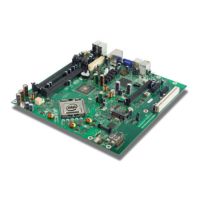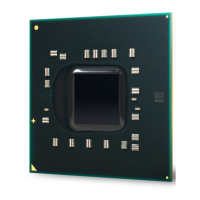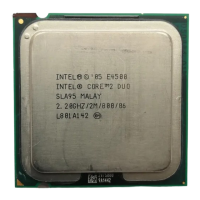Processor Thermal/Mechanical Information
Thermal and Mechanical Design Guidelines 27
2.4 System Thermal Solution Considerations
2.4.1 Chassis Thermal Design Capabilities
The Intel reference thermal solutions and Intel
®
Boxed Processor thermal solutions
assume that the chassis delivers a maximum T
A
at the inlet of the processor fan
heatsink. The following tables show the T
A
requirements for the reference solutions
and Intel
®
Boxed Processor thermal solutions.
Table 1. Heatsink Inlet Temperature of Intel Reference Thermal Solutions
Type ATX
D60188-001
ATX RCBFH-
3
ATX
RCFH-4
BTX
Type I
Heatsink Inlet
Temperature
40 °C 40 °C 39 °C 35.5 °C
NOTE:
1. Intel reference designs (D60188-001 and RCBFH-3) are assumed be used in the chassis
where expected the temperature rise is 5 °C.
2. Intel reference design (RCFH-4) is assumed be used in the thermally advantaged
chassis and expected some of the temperature rise is induced by processor heat
recirculation (refer to Thermally Advantaged Chassis version 1.1 for Thermally
Advantaged Chassis thermal and mechanical requirements).
Table 2. Heatsink Inlet Temperature of Intel
®
Boxed Processor thermal solutions
Type Boxed Processor Heatsink for
Intel
®
Core™2 Extreme quad-core processor QX6000 series at
the 775_VR_CONFIG_05B,
Intel
®
Core™2 Quad processor Q6000 series,
Intel
®
Core™2 Extreme processor QX9000 series, and
Intel
®
Core™2 Quad processor Q9000 and Q8000series
Heatsink Inlet
Temperature
39 °C
NOTE:
1. Boxed Processor thermal solutions for ATX assume the use of the thermally advantaged
chassis (refer to Thermally Advantaged Chassis version 1.1 for Thermally Advantaged
Chassis thermal and mechanical requirements).
2.4.2 Improving Chassis Thermal Performance
The heat generated by components within the chassis must be removed to provide an
adequate operating environment for both the processor and other system
components. Moving air through the chassis brings in air from the external ambient
environment and transports the heat generated by the processor and other system
components out of the system. The number, size and relative position of fans and
vents determine the chassis thermal performance, and the resulting ambient
temperature around the processor. The size and type (passive or active) of the
thermal solution and the amount of system airflow can be traded off against each
other to meet specific system design constraints. Additional constraints are board
layout, spacing, component placement, acoustic requirements and structural
considerations that limit the thermal solution size. For more information, refer to the

